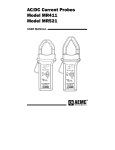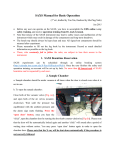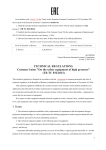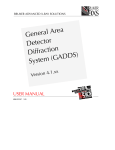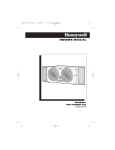Download M88-E01105 VANTEC-2000 User Manual.book
Transcript
Bruker AXS VÅNTEC-2000 User Manual Part Number: M88-E01105 Publication date: 22 May 2007 think forward X-ray Diffraction TECHNOLOGY VÅNTEC-2000 User Manual This document covers the VÅNTEC-2000 area detector. References to this document should be shown as M88-Exx105 VÅNTEC-2000 User Manual. © 2007 Bruker AXS Inc., 5465 East Cheryl Parkway, Madison, WI 53711. All world rights reserved. Notice The information in this publication is provided for reference only. All information contained in this publication is believed to be correct and complete. Bruker AXS Inc. shall not be liable for errors contained herein, nor for incidental or consequential damages in conjunction with the furnishing, performance, or use of this material. All product specifications, as well as the information contained in this publication, are subject to change without notice. This publication may contain or reference information and products protected by copyrights or patents and does not convey any license under the patent rights of Bruker AXS Inc. nor the rights of others. Bruker AXS Inc. does not assume any liabilities arising out of any infringements of patents or other rights of third parties. Bruker AXS Inc. makes no warranty of any kind with regard to this material, including but not limited to the implied warranties of merchantability and fitness for a particular purpose. No part of this publication may be stored in a retrieval system, transmitted, or reproduced in any way, including but not limited to photocopy, photography, magnetic, or other record without prior written permission of Bruker AXS Inc. Address comments to: Technical Publications Department Bruker AXS Inc. 5465 East Cheryl Parkway Madison, Wisconsin 53711-5373 USA All trademarks and registered trademarks are the sole property of their respective owners. Printed in the U.S.A. Revision History Revision Date Changes 0 03 November 2006 Initial release. 1 22 May 2007 Corrections and additions to Calibration section. Bruker BioSciences Bruker AXS Inc. 40 Manning Road Billerica, MA USA 5465 East Cheryl Parkway Madison, WI 53711-5373 USA Phone +1 (978) 663-3660 Fax: +1 (978) 667-5993 Phone +1 (800) 234-XRAY [9729] Fax +1 (608) 276-3006 E-mail: [email protected] www.bruker-biosciences.com E-mail: [email protected] www.bruker-axs.com Table of Contents 1 About This User Manual . . . . . . . . . . . . . . . . . . . . . . . . . . . . . . . . . . . . . . . . .1-1 1.1 Terms and Conventions Used in this User Manual . . . . . . . . . . . . . . . . . . . . . . . . . . . 1-1 1.1.1 1.1.2 1.2 Referenced Documentation . . . . . . . . . . . . . . . . . . . . . . . . . . . . . . . . . . . . . . . . . . . . . . 1-2 1.3 Safety Considerations . . . . . . . . . . . . . . . . . . . . . . . . . . . . . . . . . . . . . . . . . . . . . . . . . . 1-3 1.3.1 1.3.2 1.3.3 1.3.4 1.3.5 1.3.6 1.4 1-3 1-3 1-3 1-4 1-4 1-5 Technical Support . . . . . . . . . . . . . . . . . . . . . . . . . . . . . . . . . . . . . . . . . . . . . . . . 1-6 Introduction and System Description . . . . . . . . . . . . . . . . . . . . . . . . . . . . . .2-1 2.1 VÅNTEC-2000 Theory of Operation. . . . . . . . . . . . . . . . . . . . . . . . . . . . . . . . . . . . . . . . 2-2 2.1.1 2.1.2 2.1.3 2.1.4 2.1.5 2.1.6 2.1.7 X-ray Photon Conversion and Electron Multiplication . . . . . . . . . . . . . . . . . . . . . Eliminating Sparking . . . . . . . . . . . . . . . . . . . . . . . . . . . . . . . . . . . . . . . . . . . . . . Readout System. . . . . . . . . . . . . . . . . . . . . . . . . . . . . . . . . . . . . . . . . . . . . . . . . . Active Area, Geometry, and Spatial Resolution . . . . . . . . . . . . . . . . . . . . . . . . . . Counting Rates, Linearity, and Dynamic Range . . . . . . . . . . . . . . . . . . . . . . . . . Vibration and Radiation Tolerance . . . . . . . . . . . . . . . . . . . . . . . . . . . . . . . . . . . . References . . . . . . . . . . . . . . . . . . . . . . . . . . . . . . . . . . . . . . . . . . . . . . . . . . . . . . 2-2 2-3 2-3 2-3 2-4 2-4 2-4 2.2 VÅNTEC 2000 Technical Specifications . . . . . . . . . . . . . . . . . . . . . . . . . . . . . . . . . . . . 2-5 2.3 The Detector Unit . . . . . . . . . . . . . . . . . . . . . . . . . . . . . . . . . . . . . . . . . . . . . . . . . . . . . . 2-7 2.3.1 2.4 3 Qualified Personnel . . . . . . . . . . . . . . . . . . . . . . . . . . . . . . . . . . . . . . . . . . . . . . . Correct Usage . . . . . . . . . . . . . . . . . . . . . . . . . . . . . . . . . . . . . . . . . . . . . . . . . . . Hazardous Materials . . . . . . . . . . . . . . . . . . . . . . . . . . . . . . . . . . . . . . . . . . . . . . X-ray Safety . . . . . . . . . . . . . . . . . . . . . . . . . . . . . . . . . . . . . . . . . . . . . . . . . . . . . Proper Lifting . . . . . . . . . . . . . . . . . . . . . . . . . . . . . . . . . . . . . . . . . . . . . . . . . . . . Warning Labels . . . . . . . . . . . . . . . . . . . . . . . . . . . . . . . . . . . . . . . . . . . . . . . . . . Service and Technical Support for the VÅNTEC-2000 Area Detector . . . . . . . . . . . . 1-6 1.4.1 2 Typographical Conventions . . . . . . . . . . . . . . . . . . . . . . . . . . . . . . . . . . . . . . . . . 1-1 Warnings, Cautions, and Notes . . . . . . . . . . . . . . . . . . . . . . . . . . . . . . . . . . . . . . 1-2 Detector Cables and Connectors . . . . . . . . . . . . . . . . . . . . . . . . . . . . . . . . . . . . . 2-7 The Detector Controller . . . . . . . . . . . . . . . . . . . . . . . . . . . . . . . . . . . . . . . . . . . . . . . . . 2-8 Basic Operation . . . . . . . . . . . . . . . . . . . . . . . . . . . . . . . . . . . . . . . . . . . . . . . .3-1 M88-E01105 iii Table of Contents 4 3.1 VÅNTEC-2000 Power-Up Procedure . . . . . . . . . . . . . . . . . . . . . . . . . . . . . . . . . . . . . . . 3-1 3.2 VÅNTEC-2000 Power-Down Procedure. . . . . . . . . . . . . . . . . . . . . . . . . . . . . . . . . . . . . 3-2 3.3 Emergency Power-Down Procedure . . . . . . . . . . . . . . . . . . . . . . . . . . . . . . . . . . . . . . . 3-3 3.4 Disconnecting the Power Plug . . . . . . . . . . . . . . . . . . . . . . . . . . . . . . . . . . . . . . . . . . . 3-4 3.5 Lock Out. . . . . . . . . . . . . . . . . . . . . . . . . . . . . . . . . . . . . . . . . . . . . . . . . . . . . . . . . . . . . . 3-4 Calibration . . . . . . . . . . . . . . . . . . . . . . . . . . . . . . . . . . . . . . . . . . . . . . . . . . . . 4-1 4.1 Calibrate the Time Constants . . . . . . . . . . . . . . . . . . . . . . . . . . . . . . . . . . . . . . . . . . . . 4-1 4.2 Calibrate the High Voltage . . . . . . . . . . . . . . . . . . . . . . . . . . . . . . . . . . . . . . . . . . . . . . . 4-3 4.3 Set the Detector Center in PXCConfig . . . . . . . . . . . . . . . . . . . . . . . . . . . . . . . . . . . . . 4-6 4.3.1 4.3.2 4.3.3 4.3.4 4.3.5 Find and Cover the Center Hole in the Fiducial Plate . . . . . . . . . . . . . . . . . . . . . 4-6 Image the Fiducial Plate in GADDS . . . . . . . . . . . . . . . . . . . . . . . . . . . . . . . . . . . 4-6 Find Coordinates of Reference Point . . . . . . . . . . . . . . . . . . . . . . . . . . . . . . . . . . 4-8 Enter Reference Point Values into PXCConfig. . . . . . . . . . . . . . . . . . . . . . . . . . . 4-9 Use GADDS to Verify Correction to Center . . . . . . . . . . . . . . . . . . . . . . . . . . . . 4-10 4.4 Spatial Correction Calibration . . . . . . . . . . . . . . . . . . . . . . . . . . . . . . . . . . . . . . . . . . . 4-12 4.5 Flood-Field Correction Calibration . . . . . . . . . . . . . . . . . . . . . . . . . . . . . . . . . . . . . . . 4-12 4.5.1 4.6 5 VÅNTEC-2000 User Manual Examine Image for Defects . . . . . . . . . . . . . . . . . . . . . . . . . . . . . . . . . . . . . . . . 4-12 Re-Optimize the High Voltage for Your System’s Radiation. . . . . . . . . . . . . . . . . . . 4-13 Preventive Maintenance . . . . . . . . . . . . . . . . . . . . . . . . . . . . . . . . . . . . . . . . . 5-1 5.1 Cleaning the Diffraction System and Measuring Equipment . . . . . . . . . . . . . . . . . . . 5-1 5.2 Replacing Fuses . . . . . . . . . . . . . . . . . . . . . . . . . . . . . . . . . . . . . . . . . . . . . . . . . . . . . . . 5-2 Index . . . . . . . . . . . . . . . . . . . . . . . . . . . . . . . . . . . . . . . . . . . . . . . . . . . . . . . . Index-1 iv M88-E01105 1 About This User Manual 1.1 Terms and Conventions Used in this User Manual Before using this User Manual, it is important to understand the terms and typographical conventions used. Certain kinds of formatting in the User Manual’s text are used to identify special kinds of information. 1.1.1 Typographical Conventions Table 1.1 shows typographical conventions used to help you quickly locate and identify information in this User Manual. Convention Usage boldface Software interface elements (such as icons, menu items, and buttons) to be selected as part of the current procedure. italics New terms and words requiring emphasis. monospace Information read from or entered into a command prompt. > Navigation through a hierarchical menu. For example, “Choose Start > Programs > Bruker AXS > PILOT” describes navigating Windows’ menus from Start to Programs to Bruker AXS to PILOT. [square brackets] Keyboard input. Table 1.1 – Typographical conventions Greek and Roman Text This User Manual uses scientific terminology that may be rendered in Greek text. However, this User Manual follows a convention of using Roman text to the greatest extent possible. Greek Roman 2θ 2-theta θ1 theta1 θ2 theta2 ω omega φ phi χ chi Table 1.2 – Greek and Roman text M88-E01105 1-1 About This User Manual 1.1.2 VÅNTEC-2000 User Manual Warnings, Cautions, and Notes This User Manual contains notices that you must observe to ensure your own personal safety, as well as to protect the product and connected equipment. These notices are highlighted in the User Manual and are marked as follows according to the level of danger. ! WARNING The word “WARNING” alerts the reader to an immediate or potential hazard that can result in death, severe personal injury, or substantial property damage. ! CAUTION The word “CAUTION” alerts the reader to a potential practice or condition that could result in minor personal injury or damage to the product or property. NOTE: The word “NOTE” in bold capital letters draws your attention to particularly important information on the product or handling of the product, or to a particular part of the product documentation. The symbol shown above is used whenever high voltage is present. 1.2 Referenced Documentation Table 1.3 contains a list of documentation referenced in this User Manual. It is recommended to have this additional documentation available as you work with this User Manual. In the documents’ part numbers, a variable revision number is referred to by a lowercase letter “x”. Always use the most current revisions available. Documentation Part Number Title <none as of this publication> Table 1.3 – Referenced documentation 1-2 M88-E01105 VÅNTEC-2000 User Manual 1.3 Safety Considerations 1.3.1 Qualified Personnel About This User Manual The VÅNTEC-2000 may only be set up and operated in conjunction with this User Manual. Only personnel authorized by Bruker AXS are allowed to work on this equipment. All repairs, adjustments and alignments performed on any components of the VÅNTEC-2000 must be carried out strictly in accordance with the established safety practices and standards of the country where the equipment is installed. 1.3.2 Correct Usage This device and its components may only be used for the applications described in this User Manual and only in connection with devices or components from other manufacturers which have been approved or recommended by Bruker AXS. This product can only function correctly and safely if it is transported, stored, set up and installed correctly and operated and maintained as recommended by Bruker AXS. Protection provided by this equipment may be impaired if it is used in a manner not specified by Bruker AXS. 1.3.3 ! Hazardous Materials WARNING The VÅNTEC-2000’s optic assembly contains a beryllium window. Beryllium is potentially hazardous if ingested, inhaled, or absorbed through the skin. Take care to avoid contact with the VÅNTEC-2000 X-ray window. Never drill, grind or sand beryllium unless you are a qualified individual using appropriate respiratory equipment and dust containment and collection apparatus. Disposal of parts containing beryllium must comply with all applicable local and national regulations. M88-E01105 1-3 About This User Manual 1.3.4 ! VÅNTEC-2000 User Manual X-ray Safety WARNING X-ray equipment produces potentially harmful radiation and can be dangerous to anyone in the equipment’s vicinity unless safety precautions are completely understood and implemented. All persons designated to operate or perform maintenance on this instrument need to be fully trained on the nature of radiation, X-ray generating equipment, and radiation safety. All users of the X-ray equipment are required to accurately monitor their exposure to X-rays by proper use of X-ray dosimeters. For safety issues related to operation and maintenance of your particular X-ray generator, diffractometer, and shield enclosure, please refer to the manufacturer’s operation manuals or to your Radiation Safety Officer. The user is responsible for compliance with local safety regulations. 1.3.5 Proper Lifting Installation of the detector requires lifting of components that weigh up to 43 lbs (19.5 kg). Whenever possible, two or more people should lift objects together. Use proper lifting techniques at all times. Use the following steps as an overview of proper lifting techniques. • Plan: practice the lift. While lifting, bend at the knees, keep your back straight, tighten your stomach and lift with your legs. • Position: keep your body close to the object you wish to lift—your stability increases the closer you are to the object. Keep your feet shoulder width apart. • Movement: avoid making awkward movements while holding a heavy object. Get help if the object is too heavy or cumbersome. 1-4 M88-E01105 VÅNTEC-2000 User Manual 1.3.6 About This User Manual Warning Labels The following warning symbols are displayed on the detector. Strictly obey all instructions and warning text printed on the labels attached to the various parts of the equipment. ! WARNING Voltage Danger! Before installing or servicing the detector, switch off the system to avoid exposure to high voltage. Inside the VÅNTEC-2000, voltages up to 17 KV DC occur which are not accessible from the outside. High voltages exist inside the detector and in the cables with the label “HV” connecting the detector unit and the rackmountable controller. After turning off the system, high voltages are still present. They discharge over time. Wait a few minutes before removing cables from the controller unit. If one of these high-voltage components is damaged, switch off the system immediately and contact Bruker AXS Technical Support (Section 1.4). ! WARNING Sometimes complex D8 systems will be supplied by several power supply lines. The system and its components will be live until all power lines connected to the system are disconnected from the mains power supply. ! WARNING Wait 60 seconds after turning off HV power before removing HV connectors! ! WARNING The X-ray window contains Beryllium. Any activity that scratches the window surface can generate airborne beryllium dust which can cause lung disease if inhaled. Beryllium metal in solid form, and as contained in this product, presents no special health risks. For additional information, reference MSDS. The rating plate is also displayed on the detector. Model #: 672-___________ 100-240 VAC 50/60 Hz, 120 W Fuse Rating: F, 3.15 A, 250 V M88-E01105 1-5 About This User Manual 1.4 VÅNTEC-2000 User Manual Service and Technical Support for the VÅNTEC-2000 Area Detector The VÅNTEC-2000 area detector is a precision instrument and contains no user-serviceable parts. If you suspect a detector malfunction, contact Bruker AXS Technical Support. 1.4.1 Technical Support Users are invited to contact Bruker AXS whenever there are problems or questions related to the system. Before contacting Bruker AXS, please: • If there is a software problem, determine the version of the program. • Record any error messages. • Determine conditions and steps that recreate the problem. If the instrument is in North America, contact our North American Service Center: Bruker AXS North American Service Center Bruker AXS Inc. Customer Support Address: 5465 East Cheryl Parkway Madison, WI 53711-5373 USA Toll-free telephone: 1 (800) 234-XRAY [9729] Direct line: 1 (608) 276-3087 Fax: 1 (608) 276-3015 E-mail: [email protected] Web: http://www.bruker-axs.com Table 1.4 – Bruker AXS North American Service Center contact information If the instrument is outside North America, contact your local Bruker AXS Service Center. 1-6 M88-E01105 2 Introduction and System Description Figure 2.1 – VÅNTEC-2000 detector unit This User Manual covers installation and basic operation of the VÅNTEC-2000 area detector. Because of its unique ability to detect individual photons from 0 to 500,000 counts per second, the VÅNTEC-2000 is ideal for the analysis of weakly and/or strongly scattering samples — including smallest sample traces, single crystals, epitaxial thin films, coatings, rocks, polymers, metals, steel, wood, plastics, liquids, nanomaterials, and much more. The active area of the detector is 14 cm by 14 cm. The simultaneously-recorded angular range, as well as the achievable angular resolution, are influenced by the sample properties, the selected measurement circle diameter, and the applied X-ray wavelength. Generally, the para-focusing BraggBrentano geometry and a larger measurement circle diameter result in a better angular resolution. The VÅNTEC-2000 detector is based on the patented MikroGap™ technology. It offers all the benefits common with gas detectors, such as high signal amplification resulting in high peak-to-background ratio. However, the MikroGap™ technology allows operation at count rates much higher than those typically possible with gas detectors while maintaining all benefits. The factory settings are optimized for Cu Kα, minimizing background scattering and fluorescence. The VÅNTEC-2000 consists of two parts: the detector and the detector controller. M88-E01105 2-1 Introduction and System Description 2.1 VÅNTEC-2000 User Manual VÅNTEC-2000 Theory of Operation The VÅNTEC-2000 is a photon-counting X-ray area detector. The sealed chamber inside the detector is filled with xenon (with the addition of a “quencher”) at a pressure of 2 atmospheres. The schematic structure of the detector is shown in Figure 2.2. X-ray photon Be-window Ed e- Conversion/Drift Gap Grid Insulator Figure 2.2 – 2.1.1 Resistive Anode Amplification Gap Ea Induced Charge Readout strips Readout Strips VÅNTEC-2000 schematic diagram X-ray Photon Conversion and Electron Multiplication An incoming X-ray photon penetrates through the Be window into the conversion gap. In the conversion gap, the photon is converted into a small cloud of electrons. The released charge (about 4 × 10-17 Coulombs for an 8 KeV photon in Xe) is too small to be registered by contemporary electronics; therefore, internal electron multiplication is necessary. The most popular way to multiply electrons is with a “multi-wire chamber”, in which a strong electric field creates electron avalanches in the close vicinity of a grid of thin wires. Although multi-wire chambers are well-developed and fairly stable, they have two important limitations: • They limit the local counting rate capability because of the ion volume charge created near the wires; and • The pitch of the wires limits the detector’s spatial resolution. The VÅNTEC-2000’s parallel-plate geometry greatly reduces these limitations. In parallel-plate geometry, the electrons multiply all the way from the cathode to the anode (in the case of the VÅNTEC2000, the cathode is a small-cell grid that is transparent to the electrons coming from the conversion gap). 2-2 M88-E01105 VÅNTEC-2000 User Manual 2.1.2 Introduction and System Description Eliminating Sparking Despite its advantages in electron multiplication, parallel-plate geometry has the well-known problem of sparking. Bruker AXS has overcome this problem in the following ways: • The VÅNTEC-2000 is designed for X-ray diffraction applications in which the radiation is monochromatic and there are no highly ionizing particles that are the primary cause for the sparks (excluding the rare cases of cosmic rays and natural radioactivity). • The VÅNTEC-2000 uses a resistive anode with readout strips separated from the anode by a thick (3 mm) ceramic substrate. • The VÅNTEC-2000 uses a carefully-selected “quencher” that allows for stable operation with the gas gain as large as 105, without the usual polymerization and gas composition variations associated with irradiation and electron multiplication. 2.1.3 Readout System The readout strips are arranged in two parallel planes, with one plane’s strips running in the X direction and the other plane’s strips running in the Y direction. The induced charge is divided approximately evenly between the planes by adjusting both the gap between the planes and the individual strip widths. There are five signal outputs from the detector in total. Each plane’s readout strips are connected to a corresponding delay line, and each delay line has two amplifiers connected to its ends. In addition, a common signal from the grid is going out of the detector. These five outputs feed the constant fraction discriminators in the detector controller. The time-to-digital (TDC) board, located in the computer, measures the time intervals between the opposite outputs of each of the delay lines and converts them into X and Y coordinates. The TDC also checks the time relationships between all five signals and validates the events. The coordinates are registered in the 2048 by 2048 histogram memory with an average pixel size of 68 μm by 68 μm. There are two histogram memories in the TDC board. They operate in alternating fashion, with one being filled while the other transfers data to the computer memory. A time-resolving data collection with an event time resolution of one microsecond is possible that allows registration of very fast changes within the sample during the measurements. 2.1.4 Active Area, Geometry, and Spatial Resolution The sizes of the Be window, the grid, the anode, and the readout electrodes have some margins to provide the detector’s active area size to be 14 cm by 14 cm. The window has a spherical shape with a radius of 20 cm to reduce the parallax effect. The continuous nature of the anode does not limit the spatial resolution of the VÅNTEC-2000 (unlike the discrete wire spacings in multi-wire chamber detectors). The main internal processes that affect the spatial resolution are: • the range of the initial conversion electron; and • diffusion of the electron cloud while it drifts to the grid. However, for the VÅNTEC-2000 (at two atmospheres of pressure) these limitations are smaller than the contribution of electronic noise in the signal amplifiers. The resulting width of the spread function from a point-like beam is 250 microns at the detector center and 320 microns at the periphery due to the parallax effect. M88-E01105 2-3 Introduction and System Description 2.1.5 VÅNTEC-2000 User Manual Counting Rates, Linearity, and Dynamic Range The main advantage of the parallel-plate design is its high local counting rate. We have observed linear behavior up to 500 kcps/mm2 (corresponding to 2400 cps/pixel), which is several orders of magnitude higher than that achievable with multi-wire chamber detectors. A more practical value is the maximum counting rate for a point-like reflection or a narrow direct beam. Measurements with the VÅNTEC-2000 have shown a maximum counting rate of 250 kcps (linear up to 160 kcps). The potential global counting rate is also high. However, in the case of the VÅNTEC-2000, the global counting rate is limited by the delay line readout. We observe 1.6 Mcps as the maximum value (linear up to 0.9 Mcps). The maximum dynamic range, determined as the ratio of the maximum counting rate per reflection to the background fluctuations in the area occupied by the reflection, is also very high due to the high local counting rate. We estimate the maximum dynamic range to be 109 multiplied by the square root of the collection time in seconds. The background counting rate is determined by cosmic rays and the material’s natural radioactivity. Typically, it is less than 5 cps uniformly distributed over the whole detector area. 2.1.6 Vibration and Radiation Tolerance The VÅNTEC-2000’s design is robust. There are no shaky parts like thin wires inside, so the detector is vibration-tolerant compared to multi-wire chamber detectors. However, the detector’s most important quality is its radiation hardness, unprecedented among detectors with gas multiplication. We have noticed no damage up to a cumulative irradiation of 2 × 1012 counts per mm2, corresponding to a total acceptable irradiation of more than 1016 X-ray photons for the whole detector. Due to the resistive anode and the stable gas mixture, the VÅNTEC-2000 tolerates accidental intensive irradiations. In such cases, the anode voltage drops in the irradiated part of the detector, suppressing the multiplication process. The irradiated part (or the entire detector) is momentarily rendered ineffective, but no lasting damage occurs. 2.1.7 References D. M. Khazins, B. L. Becker, B. B. He, Y. Diawara, R. D. Durst, S. A. Medved, V. Sedov, and T. A. Thorson, “A Parallel-Plate Resistive-Anode Gaseous Detector for X-Ray Imaging,” IEEE Trans. Nucl. Sci., vol. 51, pp. 943 – 947, June 2004. R. D. Durst, S. N. Carney, Y. Diawara, R. Shuvalov, “ Readout structure and technique for electron cloud avalanche detectors,” US Patent No. 6,340,819, January 2002. 2-4 M88-E01105 VÅNTEC-2000 User Manual 2.2 Introduction and System Description VÅNTEC 2000 Technical Specifications Detector Specifications Sensor Type Xe-based gaseous avalanche detector Usable wavelength range From Cr-Kα up to Mo-Kα, factory-set default for Cu-Kα Gas fill 2 ATM Xenon-based proprietary gas mixture, no external gas supply required Window type Be Sensor Active Area 14 x 14 cm2 Window Size 14 x 14 cm2 Number of Pixels 2048 × 2048 Sensor Pixel Size 68 μm × 68 μm Point Spread Function (FWHM) 250 μm at the sensor center, 320 μm at the periphery Global Counting Rate Maximum 1.6 Mcps Linear part (10% deviation from linearity) 0.9 Mcps Local Counting Rate Maximum per a point-like reflection 250 kcps Linear part (10% deviation from linearity) 160 kcps Background < 5 cps per whole area Maximum Dynamic Range 109 × sqrt(collection time in seconds) Radiation Hardness 1012 X-ray photons/mm2 (1016 photons in total) Accidental Irradiation Intensity No limits Expected Re-gassing Period 5 years Table 2.1 – Detector specifications M88-E01105 2-5 Introduction and System Description VÅNTEC-2000 User Manual Electrical Specifications Voltage of power supply 100–240 V AC Frequency of power supply 50/60 Hz Power rating 120 W Length of cables between the detector and the controller chassis unit 16.4 ft (5 m) Table 2.2 – Electrical specifications Environmental Specifications Ambient temperature 41–104°F (5–40°C) Operating temperature 57–93°F (14–34°C) Maximum temperature gradient 0.9°F (0.5°C) per hour Relative humidity Max 80%, non-condensing, for temperatures up to 88°F (31°C) decreasing linearly to 50% at 104°F (40°C) Location of use Indoor Altitude Up to 1.2 miles (2000 m) Mains supply voltage fluctuations Up to ±10% of the nominal voltage Overvoltage category IEC 664 II Pollution degree 2 Table 2.3 – Environmental specifications 2-6 M88-E01105 VÅNTEC-2000 User Manual 2.3 Introduction and System Description The Detector Unit The detector unit consists of a pressure vessel at 2 atmospheres with a back cover (see Figure 2.1). The VÅNTEC-2000 is a single-photon counting detector which converts the X-ray photons to electrical signals. The signals are amplified by five amplifiers attached to the detector. The high-voltage filters and preamps are mounted into the back cover of the detector. 2.3.1 Detector Cables and Connectors Eleven cables are delivered with the detector: • Power cable • Serial cable • Five 15 ft (5 m) preamp cables (Ch 1, Ch 2, Ch 5) • Low-voltage (detector) cable • Two high-voltage power cables • SCSI interconnection cable The detector unit’s back cover has eight cable connectors (Figure 2.3): • One connector for the preamplifiers’ low voltage power supply • Two cables for the detector’s high-voltage supply • Five signal outputs for the preamplifiers High- voltage cables (permanently attached) Low-voltage power supply Channel 4 Channel 2 Channel 5 Channel 1 Channel 3 Figure 2.3 – M88-E01105 Detector unit (rear) 2-7 Introduction and System Description 2.4 VÅNTEC-2000 User Manual The Detector Controller Fan filters Illuminated high voltage enable push-button switch LED Indicators: Illuminated power switch Alarm–Red System activity–Green (blinking) HV OK–Yellow LV OK–Green Figure 2.4 – Detector controller (front) Channels 1-5 Low-voltage connection Grid HV Anode HV Figure 2.5 – 2-8 Power receptacle TDC connection Detector controller (rear) M88-E01105 3 Basic Operation This Section covers the power-up, power-down, and basic operation procedures for the VÅNTEC-2000 detector. 3.1 VÅNTEC-2000 Power-Up Procedure 1. Press the I/O button on the front of the VÅNTEC-2000 controller. The I/O button illuminates when power is present. If the I/O button doesn’t illuminate, ensure that there is power applied to the D8 system by pressing the Power ON button located on the right side column of the D8 enclosure. 2. Turn on the high voltage for the detector by pressing the high voltage enable button on the front of the VÅNTEC-2000 controller. If power and communications for the controller are properly applied, there should be no warning LED illuminated. The system LED will flash, indicating communication and control. The high voltage LED will be yellow and illuminated. The low voltage LED will be green and illuminated. NOTE: The VÅNTEC-2000 controller requires 15 minutes to warm up for optimal results. M88-E01105 3-1 Basic Operation 3.2 VÅNTEC-2000 User Manual VÅNTEC-2000 Power-Down Procedure 1. Press the high voltage enable button on the front of the VÅNTEC-2000 controller. If the high voltage button is not illuminated, this indicates that high voltage for the detector is OFF. 2. Press the I/O button on the front of the VÅNTEC-2000 controller to switch off the power. ! WARNING Wait 60 seconds after turning off HV power before removing the HV connectors! 3. Press the Power OFF button (O) on the D8 enclosure’s right-hand column to stop power to the control electronics, high voltage generator, and the VÅNTEC-2000 controller, when the controllers are connected to X602. 4. Before switching off the diffraction system, reduce the high voltage and current of the generator to the lowest values (e.g., 20 kV/5 mA) using the control software (e.g., XRD COMMANDER). 5. Turn off the high voltage generator by turning the rotary switch “High Voltage” to the left side. The X-RAY ON displays will turn off. 6. Switch off the instrument by pressing the enclosure’s Power OFF button. ! CAUTION Failure to reduce the generator high voltage and current prior to shutting off the D8 could significantly reduce the lifetime of the X-ray tube and the high voltage generator. 3-2 M88-E01105 VÅNTEC-2000 User Manual 3.3 Basic Operation Emergency Power-Down Procedure The main power for the VÅNTEC-2000 controller is connected to X601, located on the left side of the D8 lower enclosure. 1. In the event of an emergency, press either Stop button located on the enclosure’s front side columns to switch off power to the control electronics, high voltage generator, and the VÅNTEC2000 controller, when the controllers are connected to X602. Use the Stop button to immediately shut off power to the X-ray source and stop all moving drives instantly. The Stop button should only be used in emergency situations and not for normal shutdown of the diffractometer system. ! WARNING The Stop button will not turn off the three AC outlets (X601) that are located on the mains distribution panel! Devices connected to these AC outlets can only be switched off by the internal automatic circuit breaker labelled F600 or the external power switch that is installed on the user’s side close to the diffractometer. The control panels of the D8 diffraction system are located on the front side of the system. X602 is supplied power as long as the D8 On/Off switch (on the right-hand column of the D8 cabinet) is enabled and the two emergency Stop switches are not engaged. 2. To disengage the Stop button, turn the button clockwise and release. Re-apply power with the Power On button that is on the right side column of the D8 enclosure. M88-E01105 3-3 Basic Operation 3.4 VÅNTEC-2000 User Manual Disconnecting the Power Plug To remove, relocate or service the detector controller, it may be necessary to disconnect the power cable from the rear of the controller. 1. Ensure that all power is off to the enclosure prior to removing the power cord. 2. Remove the rear access panel of the D8 enclosure. Use caution when removing the panel as the ventilation fans are connected to it. 3. Visually inspect the power cord for frayed or exposed wiring prior to removal. If the power cord appears defective, contact Bruker AXS Service for replacement by qualified service personnel. 4. With the access panel removed, firmly grasp the power cord of the detector controller at the strain relief and pull the cord from the controller. 5. The power cord is connected to X601 on the left side of the D8 enclosure. Pull the plug from this outlet strip. 3.5 1. Lock Out Use the key located on the left side column of the D8 enclosure to lock and unlock the system. During normal operation, the key must be switched to the unlocked position. In the unlocked position, power may be applied with the ON button located on the right-hand column of the D8 enclosure. In the locked position, no power will be available for the control electronics, generator or X602 connectors. The key can only be removed in the locked position. ! CAUTION Power will still be present at the X601 connectors. Electric shock can result if proper safety precautions are not observed. 3-4 M88-E01105 4 Calibration 4.1 Calibrate the Time Constants 1. Use D8Tools to irradiate the detector as you would in a flood-field setup. For calibration, we want 100,000 to 200,000 counts/second, uniformly distributed across the face of the detector. The ideal setting is 150,000 counts/second. NOTE: It is acceptable, with Cu radiation, to use an open collimator with roughly 40kV, 10mA and Fe foil at 45°. Do not use a direct beam. 2. In PXCConfig, select the TDC Board tab. Figure 4.1 – M88-E01105 TDC board tab 4-1 Calibration 3. VÅNTEC-2000 User Manual With the shutter open, click Get raw data. The system collects uncalibrated data for a short time. After a few seconds, the TWindow parameters will be updated. NOTE: Check that registers “07” and “08” both begin with the number 1. If the registers do not both begin with 1, simply replace the first digit with 1 and click Update to update the registers. Figure 4.2 – 4. TWindow values updated Click Calculate. PXCConfig uses the raw data to calculate optimal calibration time constants and updates the registers in the “Calibrated Values” area. Figure 4.3 – Calibrated values updated 5. Click Update. Calibrated values are copied to the TDC constants, and PXCConfig updates the values in the “INI Settings” area. 6. Click Load. The registers under “Current Status” are updated. 4-2 M88-E01105 VÅNTEC-2000 User Manual 7. Calibration Click Save INI. A “Created new brukerinstrument.ini” window appears. NOTE: It is necessary to click Load after Update every time. Otherwise, the next calibration, if repeated, will give an incorrect result. 4.2 Calibrate the High Voltage The optimal value of the multiplication voltage depends on the radiation’s wavelength and on the intensity when the global count rate exceeds 500 kcps. 1. In PXCConfig, select the HV scan tab. 2. Set up the scan parameters according to Figure 4.4. This is a scan through a wide range of voltage values to help you isolate the optimum range for your detector (the default start and stop voltages are set by PXCconfig as the multiplication voltage ± 200V). These values will vary. Figure 4.4 – HV scan initial parameters 3. Click Start to collect the “Counting Rate vs. voltage” data. 4. Examine the bell curve formed by the data. If you cannot see the whole plot, you can abort the scan with the Abort button, change the start and stop voltages, and click Start again. In this example, there is a flat area from approximately 7600V up to 7850V, so the working multiplication voltage for the detector will be the middle of the flat area (7675V). M88-E01105 4-3 Calibration VÅNTEC-2000 User Manual NOTE: If the flat area of the “Counting Rate vs. voltage” graph is wider than 150 volts, choose the multiplication voltage as the beginning of the flat area + 75 volts. NOTE: In situations where the detector is being calibrated after a “cold” start-up (i.e., powering up the detector after more than 6 hours of inactivity), it is necessary to perform the HV scan three times over the course of an hour. Use the third of the three results for the multiplication voltage. We define the plateau as beginning at 95% of the curve’s maximum. The plateau may be between 100,000 and 200,000 counts/sec; the ideal value is 150,000 counts/ sec. Figure 4.5 – 4-4 Counting rate vs. voltage plot M88-E01105 VÅNTEC-2000 User Manual 5. Calibration Switch to the “RC board” tab and update the multiplication voltage if necessary. Figure 4.6 – Update the multiplication voltage 6. Click Load. 7. Click Save INI. 8. Close PXCConfig. NOTE: IMPORTANT! After you are finished with the detector configuration with PXCConfig, verify that the same brukerinstrument.ini file is located in both C:\saxi\gaddsnew and C:\Program Files\BrukerAXS\BCP and BIS. The two files need to be exactly the same so that both GADDS and PILOT can access the same file; simply copy the whole file to the \GADDS folder. M88-E01105 4-5 Calibration 4.3 VÅNTEC-2000 User Manual Set the Detector Center in PXCConfig The idea is to shift the whole image by choosing any reference point on the image (in this example we use the central point of the fiducial plate), and then moving the reference point to the desired position by using the reference point’s current coordinates to recalculate the detector’s TDC constants. 4.3.1 Find and Cover the Center Hole in the Fiducial Plate If you don’t mark the center of the fiducial plate before doing the spatial, you will have to count the spots on the screen to find the one at the center. It is quicker to mark the center hole with a piece of lead tape for this add. NOTE: The plate is 29 holes by 29 holes. Put a small piece of lead tape over the center hole so that there are 14 open holes in any direction from the center. 4.3.2 Image the Fiducial Plate in GADDS 1. Set up the system with a fluorescing foil, 2-theta = 45°, and DX = 15 cm. 2. Start GADDS by selecting Start > Programs > Bruker AXS > gadds. GADDS automatically connects to the goniometer controller. 3. Select Edit > Configure... > User Settings. Under “Detector”, set the Framesize to 2048x2048. 4. Select Collect > Add and set the parameters as in Figure 4.7: Figure 4.7 – 4-6 Add parameters M88-E01105 VÅNTEC-2000 User Manual 5. Calibration Click OK to collect for 30 seconds. If the detector is functioning properly, your image will look like Figure 4.8 (note that, in Figure 4.8, the overall image is displaced to the right). Figure 4.8 – Verify image without fiducial plate 6. Put the fiducial plate on the face of the detector, aligned with the pins on the detector face, and secure it with screws. 7. Collect again (as in step 4 of this Section) to see the array of spots. Figure 4.9 – M88-E01105 Fiducial plate image missing center spot 4-7 Calibration 4.3.3 VÅNTEC-2000 User Manual Find Coordinates of Reference Point 1. Zoom into the displayed frame using Edit > Zoom. Click the 4x button. 2. Find the coordinates of the central point by placing the pixel cursor (Analyze > Cursors > Pixel or the [F7] key) along a line with the rows and columns of other spots and reading the X-pixel and Ypixel values. Record the coordinates of the central point (in Figure 4.10, they are X=1046, Y=1036). Figure 4.10 – Zoomed-in view of the missing spot 3. 4-8 Close GADDS. M88-E01105 VÅNTEC-2000 User Manual 4.3.4 Calibration Enter Reference Point Values into PXCConfig 1. Open PXCConfig and select the TDC Board tab. 2. Enter your measured and required reference point coordinates as shown in Figure 4.11. Enter the reference point coordinates you measured here. Make sure that the “(0,0) is LL” checkbox is checked. Make sure that the Ref. point required coordinates are X=1023, Y=1023. Figure 4.11 – Reference point measured and required coordinates 3. Click Get raw data. 4. Click Calculate. 5. Click Update. 6. Set the “reference point coordinates” to X=1023, Y=1023. 7. Click Load. 8. Click Save INI. 9. Click Disconnect. After disconnecting, you will be able to run GADDS. M88-E01105 4-9 Calibration 4.3.5 1. VÅNTEC-2000 User Manual Use GADDS to Verify Correction to Center To check the corrected position, start GADDS again and repeat Section 4.3.2. When you are done, you will have the image in Figure 4.12. Figure 4.12 – Fiducial plate image missing center spot (after correction) 2. Measure the reference (central) point position as in Section 4.3.3 and verify that it is located at the desired coordinates (1023, 1023) ±2 pixels. Figure 4.13 – Zoomed-in view of the missing spot (after correction) 4 - 10 M88-E01105 VÅNTEC-2000 User Manual 3. Remove the fiducial plate. 4. Collect again to verify that the flood field image is in the center of the display. Calibration Figure 4.14 – Centered image NOTE: The BrukerInstrument.ini file saves all of the setup parameters calibrated above. There is no need to repeat the Time Constant calibration or reset the detector center as long as no changes are made to the detector hardware, controller, TDC board, or cables. The high voltage calibration needs to be checked periodically (about every two weeks for a new installation). M88-E01105 4 - 11 Calibration 4.4 VÅNTEC-2000 User Manual Spatial Correction Calibration The spatial calibration must be updated every time the sample-detector distance is changed. However, it is possible to collect several spatial calibration files at different distances and then use them as needed. The spatial correction requires 1.5 million counts. 1. Put the fiducial plate on the detector. 2. Drive the detector to the appropriate position for taking a spatial. 3. Determine how long it will take the detector to accumulate 1.5 million counts by adding and looking at the total counts value. 4. In GADDS, select Process > Spatial > New and use the time value you found. 4.5 Flood-Field Correction Calibration The flood-field calibration must be updated every time the sample-detector distance is changed. However, it is possible to collect several flood-field calibration files at different distances and then use them as needed. A flood-field correction done in the field should be 100 million counts for bench-testing and basic functionality tests. For real-world use, we recommend using a flood-field of 400 million counts. 4.5.1 1. Examine Image for Defects Perform a 100 second add, just to see whether there are any defects in the image. NOTE: If you see any dark spots on the image, you can “burn” them off by placing an Fe55 source directly over the spot on the detector where you saw the cold spot (let it sit for about an hour). 2. When the flood-field correction is done, a “Click to display self-corrected image” window appears. Click OK. 3. A “Click to unwarp self-corrected image” window appears. Click OK. GADDS displays the data collected for the flood-field with the flood-field and spatial applied. 4. Examine the image for asymmetry or intensity problems. 4 - 12 M88-E01105 VÅNTEC-2000 User Manual 4.6 Calibration Re-Optimize the High Voltage for Your System’s Radiation In Section 4.2, we set the optimum high voltage for calibration using radiation from a fluorescing foil. At this high voltage setting, the detector will not be optimally sensitive to the radiation used in actual experimental situations. 1. Remove the fluorescing foil from the system and replace it with a sample that is expected to diffract well (in the case of Cu radiation, we recommend using corundum). 2. Drive the goniometer such that the detector is out of the way of the direct beam, but scattering and diffraction from the sample will be visible to the detector. 3. Using D8Tools, open the shutter. 4. Perform all of the steps in Section 4.2 to optimize the detector for use with your system’s radiation. M88-E01105 4 - 13 Calibration 4 - 14 VÅNTEC-2000 User Manual M88-E01105 5 Preventive Maintenance The components of the VÅNTEC-2000 are maintenance-free for the user. However, Bruker AXS recommends a yearly preventive maintenance inspection. To schedule this inspection or for technical support, contact your local Bruker AXS Service Department (for the U.S.A., call 1-800-234-XRAY [9729]). 5.1 ! Cleaning the Diffraction System and Measuring Equipment CAUTION Before cleaning the equipment, turn off power to the complete diffraction system (i.e., all control electronics, accessory components, and the high voltage generator). ! WARNING Do not touch the front window of the X-ray detector and the X-ray tube as they contain beryllium. Beryllium is potentially hazardous if ingested, inhaled or absorbed through the skin. Take care to avoid contact with the VÅNTEC2000’s X-ray window. Never drill, grind or sand beryllium unless you are a qualified individual using appropriate respiratory equipment and dust containment and collection apparatus. Disposal of parts containing beryllium must comply with all applicable national regulations. To clean the interior of the enclosure and exterior of the detector components, use dry cleaning utensils only. Do not use water or aggressive cleaning agents. Clean laboratory conditions are recommended. Airflow is critical for maintaining proper operation of the detector control electronics. Do not place anything on the controllers that may restrict the flow of air. Regular cleaning of the detector components includes removal of any airflow restrictions, including dust. M88-E01105 5-1 Preventive Maintenance 5.2 VÅNTEC-2000 User Manual Replacing Fuses 1. Unplug the power cable before replacing the fuse. 2. Locate the fuse cover on the rear of the detector controller. 3. Carefully remove the fuse from its holder. You may need a small screwdriver or needle-nose pliers to pry open the fuse cover (see VÅNTEC-2000). NOTE: Replace the fuse only with the specified replacement. Do not substitute a fuse with a different rating. 4. Insert the new fuse into the holder. Verify complete seating of the new fuse. 5. Replace the fuse cover. 6. Replace the power cable. If the controller continues to blow fuses or if any function does not work correctly after replacing the fuse, contact Bruker AXS Service for repair assistance. Discontinue use of the controller if it is not functioning properly. Figure 5.1 – 5-2 Fuse close-up M88-E01105 Index Numerics 0,0 is LL checkbox 4-9 A Abort button active area active area size Altitude amplifiers and preamplifiers anode 4-3 2-1 2-3 2-6 2-7 2-4 2-7 4-1 1-2 2-4 E electron avalanches Electron Multiplication Emergency Power-down Procedure 2-2 2-2 3-3 F B background Beryllium health warning Proper disposal warning Bruker AXS Service Department brukerinstrument.ini 4-3, 4-5, Detector overview direct beam Documentation Conventions Notes dynamic range 2-4 1-3 1-5 1-3 5-1 5-1 4-11 Fans on controller Fiducial Plate center hole Flood-Field Correction Fuses replacing 2-8 4-6 4-12 5-2 G C Cables included cables Calculate button Cautions cleaning cold start-up Controller front cosmic rays Counting Rate vs. voltage data Current Status registers 2-7 2-7 4-2 1-2 5-1 4-4 2-8 2-3 4-3 4-2 D Detector Center Detector Controller LED Indicators warm-up time M88-E01105 4-6 2-8 3-1 GADDS gas gain Get raw data button global counting rate 4-5 2-3 4-2 2-4 H Help high voltage turning on High Voltage calibration high voltage LED humidity HV connectors wait before removing HV scan parameters HV scan tab HV scan with cold startup 1-6 3-1 4-3 3-1 2-6 1-5 4-3 4-3 4-4 Index - 1 Index VÅNTEC-2000 User Manual I irradiation (accidental and intensive) 2-4 K key switch 3-4 L LED Indicators on controller lifting techniques linearity Load button Lock Out low voltage LED Low-voltage connection 2-8 1-4 2-4 4-2 3-4 3-1 2-8 M Mains supply voltage fluctuations Mikrogap multiplication voltage multi-wire chambers 2-6 2-1 4-3 2-2 N noise 2-3 2-3 P parallel-plane design PILOT pixel cursor Plateau defined for HV scan Power Plug disconnection power switch Power-Down Procedure emergency reducing high voltage Power-Up Procedure preventive maintenance 4-8 4-9 4-13 S Safety Safety Issues proper lifting Safety issues Save INI button Service Sparking Spatial Correction spatial resolution Specifications spread function system LED 1-3 1-4 1-4 4-3 1-6 2-3 4-12 2-2 2-5 2-3 3-1 T TDC board TDC Board tab Technical Support temperature Time Constants calibration TWindow parameters 2-3 4-1 1-6 2-6 4-1 4-2 U O outputs Reference Point in PXCConfig Re-optimizing after calibration 2-2, 2-3 4-5 4-8 4-4 3-4 2-8 3-2 3-3 3-2 3-1 5-1 Update button Usable wavelength range 4-2 2-5 V VÅNTEC-1 detector active area Detector Specifications pressurization Vibration 2-1 2-6 2-7 2-4 W Warning Labels Warnings 1-5 1-2 X Q quencher 2-3 R radiation hardness RC board tab Index - 2 X601 not turned off by Stop button X-ray safety issues X-ray tube service life 3-3 1-4 3-2 2-4 4-5 M88-E01105








































